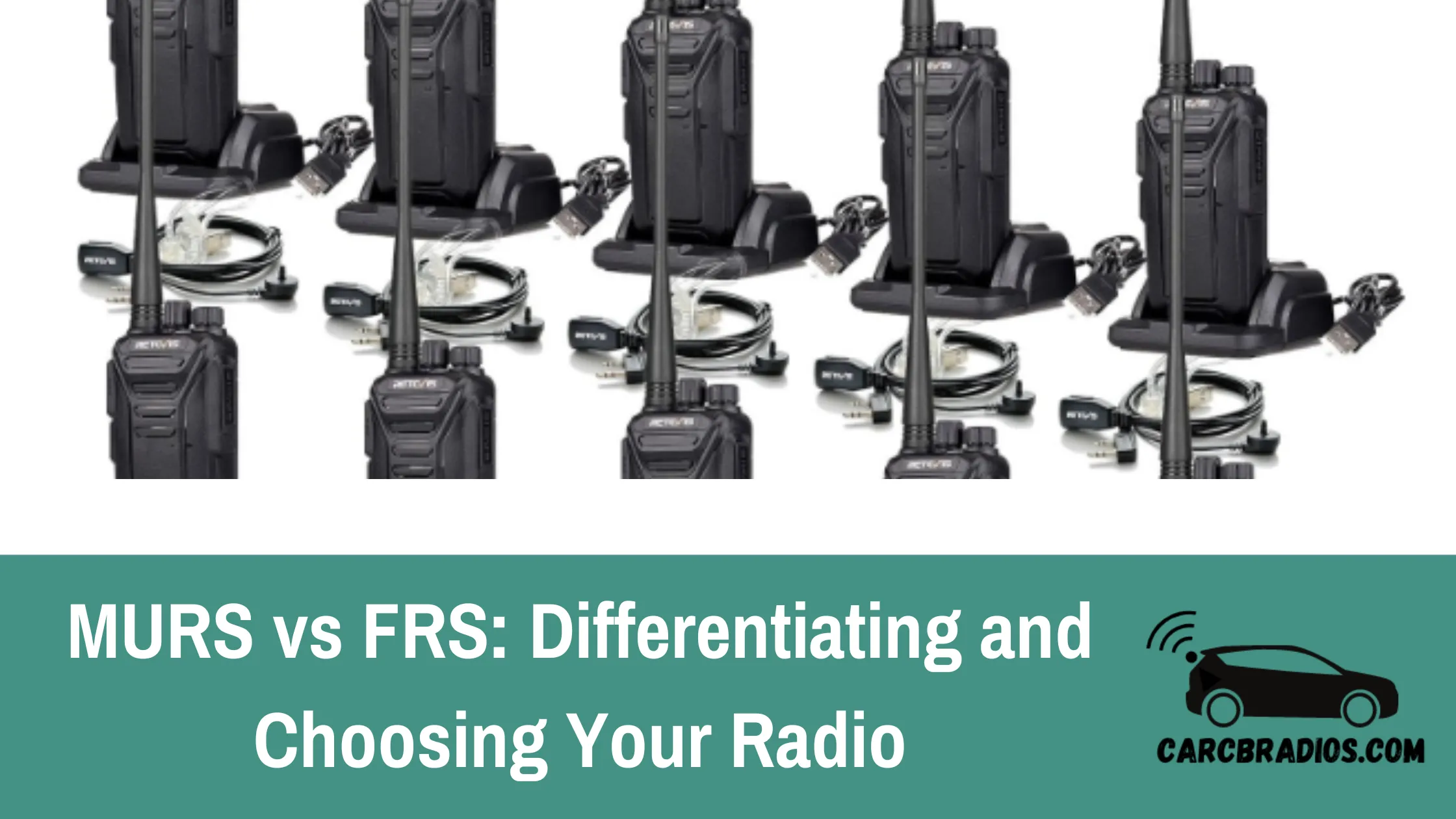By: Jeremy Neisser
As an avid outdoors enthusiast, I am always looking for the best communication devices to take with me on my adventures. Two popular options for short-range communication are MURS and FRS radios. MURS stands for Multi-Use Radio Service, while FRS stands for Family Radio Service. While both types of radios have their advantages, choosing the right one for your needs can make all the difference in staying connected in the great outdoors.
Understanding MURS is essential in determining if it is the right choice for you. MURS radios operate on five VHF frequencies, and they have a range of up to several miles, depending on terrain and weather conditions. MURS radios are typically used for personal and business communications and do not require a license to operate.
On the other hand, FRS radios operate on 22 UHF channels and have a range of up to two miles. They are commonly used for family activities, such as camping and hiking, and do not require a license to operate. FRS radios are also usually less expensive than MURS radios.
Key Takeaways
MURS radios operate on five VHF frequencies and have a range of up to several miles, while FRS radios operate on 22 UHF channels and have a range of up to two miles.
MURS radios are typically used for personal and business communications, while FRS radios are commonly used for family activities such as camping and hiking.
Choosing the right radio for your needs can make all the difference in staying connected in the great outdoors.
Understanding MURS
Definition of MURS
MURS stands for Multi-Use Radio Service. MURS is a two-way radio communication service that operates on five VHF frequencies in the 151-154 MHz band. It is a license-free service that allows for personal and business use. MURS is designed for short-range communication, typically up to two miles or less, depending on the terrain and antenna height.
Key Features of MURS
MURS radios have several key features that make them popular for personal and business use. Some of these features include:
License-free operation
Five channels available for use
High power output of up to 2 watts
Voice-activated transmission (VOX) for hands-free operation
Privacy codes to prevent interference from other users
Compatibility with other VHF radios
Pros and Cons of MURS
MURS radios have both advantages and disadvantages that users should consider before choosing this service.
Pros
No license required: MURS radios can be used without obtaining a license from the Federal Communications Commission (FCC).
Low cost: MURS radios are generally less expensive than other two-way radios and do not require ongoing licensing fees.
Easy to use: MURS radios are simple to operate and require minimal setup.
Good for short-range communication: MURS radios are ideal for communication over short distances, making them a good choice for personal and business use.
Cons
Limited range: MURS radios are designed for short-range communication and may not be suitable for long-range communication needs.
Interference: MURS radios can experience interference from other users on the same frequency, especially in busy areas.
Limited channels: MURS radios only have five channels available, which may limit communication options in some situations.
Limited privacy: While MURS radios have privacy codes to prevent interference, they do not offer the same level of privacy as licensed radio services.
Overall, MURS radios can be a good choice for personal and business use, especially for short-range communication needs. However, users should be aware of the limitations of the service and consider their specific communication needs before choosing MURS.
Understanding FRS
Definition of FRS
FRS stands for Family Radio Service, which is a type of two-way radio communication system that operates on a set of frequencies designated by the Federal Communications Commission (FCC). FRS radios are typically low-powered, handheld devices that are easy to use and do not require any special licensing or training to operate.
Key Features of FRS
FRS radios are designed for short-range communication, typically up to two miles or less, depending on the terrain and other factors. They are ideal for use in outdoor activities such as hiking, camping, and hunting, as well as for communication between family members or small groups.
Some key features of FRS radios include:
Compact and portable design
Easy-to-use interface
Multiple channels for communication
Privacy codes to prevent interference from other users
Weather alerts and emergency channels
Pros and Cons of FRS
Like any communication system, FRS has its pros and cons. Some advantages of FRS include:
Low cost and easy availability
No licensing or training required
Ideal for short-range communication
Can be used in a variety of outdoor activities
However, there are also some disadvantages to consider:
Limited range and signal quality
Susceptible to interference from other users
Not suitable for long-distance communication
Limited privacy and security features
Overall, FRS is a useful and convenient communication system for short-range communication. However, it may not be the best choice for all situations, and users should be aware of its limitations and potential drawbacks.
MURS vs FRS
Frequency Range
MURS (Multi-Use Radio Service) and FRS (Family Radio Service) are two types of walkie-talkie radios that operate on different frequency ranges. MURS radios operate on five channels in the VHF (Very High Frequency) range between 151-154 MHz, while FRS radios operate on 22 channels in the UHF (Ultra High Frequency) range between 462-467 MHz.
Range of Communication
When it comes to range of communication, FRS radios generally have a shorter range than MURS radios. FRS radios typically have a range of up to 2 miles in open areas, while MURS radios can reach up to 4 miles in open areas. However, the range can vary depending on the terrain and obstacles in the area.
Licence Requirements
MURS radios do not require a license to operate, while FRS radios are license-free for personal use. However, FRS radios require a license if they are used for business purposes or if they have more than 2 watts of power output.
Use Cases
MURS radios are ideal for outdoor activities such as camping, hiking, and hunting, as well as for small businesses that require communication within a limited range. FRS radios are suitable for family use, as well as for short-range communication in urban areas.
In summary, MURS and FRS radios have their own advantages and disadvantages based on their frequency range, range of communication, and license requirements. It's important to choose the right type of radio based on your specific needs and use case.
Conclusion
In conclusion, MURS and FRS are both great options for short-range communication. Each system has its own advantages and disadvantages, and the choice ultimately depends on the specific needs of the user.
MURS offers more channels and higher power output, making it a better choice for longer distances and more rugged terrain. However, it requires a license to operate and may not be as widely available as FRS radios.
FRS, on the other hand, is more widely available and requires no license to operate. It is also more affordable and easier to use, making it a great choice for casual users and families. However, it has fewer channels and lower power output, limiting its range and effectiveness in certain situations.
Overall, both MURS and FRS have their own strengths and weaknesses, and the decision between them should be based on the specific needs of the user. Whether you're a hiker, camper, or just looking for a way to stay in touch with your family, both systems offer a reliable and effective way to communicate over short distances.
Frequently Asked Questions
What are the 5 MURS frequencies?
MURS (Multi-Use Radio Service) has 5 frequencies that are available for public use. These frequencies are 151.820 MHz, 151.880 MHz, 151.940 MHz, 154.570 MHz, and 154.600 MHz.
MURS vs GMRS range: which is better?
MURS and GMRS (General Mobile Radio Service) both have similar ranges, but GMRS radios can transmit at higher power levels than MURS radios, which can result in a longer range. However, GMRS requires a license to operate, while MURS does not.
What is the range of MURS radios?
The range of MURS radios can vary depending on the terrain and obstacles in the area, as well as the power output of the radio. In general, MURS radios have a range of up to several miles.
What are the MURS repeater frequencies?
MURS repeater frequencies are not officially designated by the FCC, but some MURS radios can be programmed to use repeater frequencies in the 151-154 MHz range.
Is MURS radio better than FRS?
MURS and FRS (Family Radio Service) are both good options for short-range communication, but MURS radios have more frequencies available and can transmit at higher power levels than FRS radios. However, FRS radios do not require a license to operate.
What is MURS radio good for?
MURS radios are a good option for short-range communication in a variety of settings, such as outdoor activities, events, and small businesses. They can also be used for emergency communication and coordination.

Hi & Welcome!
My name is Jeremy and I have been an avid car nut for many year. My first car was an 1987 Honda CRX. I put in my first Kenwood stereo, amp, 2 10" JLs and a CB Radio in it and have been an avid user of CBs and car radios for years. I'll do my best to share my tips, information and thoughts to help you with whatever question you might have, ABOUT ME
After I graduated from High School, I worked 5 years are Radio Shack and 3 years at Circuit City answering questions and helping customers with various electronics questions.

